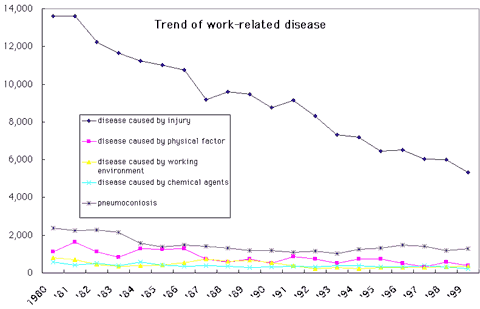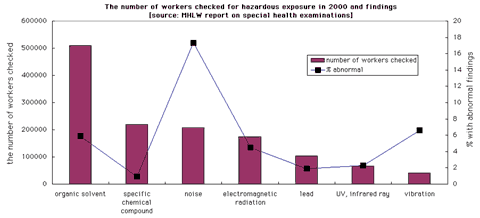|
Chapter 8 . Industrial Health |
| 1. Historical background |
|
The origin of Japan's occupational safety and health can be traced back to the Factory Act in 1911 (became effective in 1916) with an intention to protect young or female workers from exhaustive and dangerous working conditions mostly in the then bourgeoning textile industry. The scope of the act had been gradually expanded, but the all-encompassing act to protect workers of all industries was not enacted until the post war era. The Labor Standard Act was enacted in 1947. In later years, the increasing number of work-related accidents, most prominent of which were large scaled gas explosions in mines, prompted a series of enactments of working condition safe guards. Also, chronic work-related diseases such as pneumoconiosis among mine workers and Raynaud disease among forest workers using chain saws alerted industries the importance of preventive measures and health maintenance for the workers. In 1955, special acts for silicosis and traumatic spinal injuries were enacted to promote such measures. In 1972, the Occupational Safety and Health Act (OSHA) was separated from the Labor Standard Act and established the industrial doctors as a medical specialty. |
| 2. Administrative structure of occupational safety and health |
|
Under the OSHA, employers who employ 50 or more workers will be required to contract an industrial doctor. Also, employers who employ 1000 or more workers (including employers of certain industry who employ 500 or more workers) must employ an industrial doctor on a full time basis. Industrial doctors are responsible for health maintenance of all workers and must conduct an on-site inspection of the working conditions to make sure the conditions are safe and healthy. Industrial doctors are charged with suggesting professional opinions to employers and managers with regard to safety and health maintenance of the workers although these opinions are not legally binding. All employers, regardless of industries, are required to conduct health check-ups once a year. For workers working under special conditions, additional exams are included in the regular health check-ups. |
| 3. Work-related accidents |
|
The number of victims of work-related accidents has been declining steadily since its peak in 1961. This is a sharp contrast to the steady increase of the number of traffic accidents victims. When one compares the number of new recipients of the Workers' Compensation Insurance to the number of traffic accidents victims, they were almost similar at around 800,000 in 1990. The number of new recipients of the Workers' Compensation Insurance has since declined to around 600,000 a year, while the number of traffic accidents victims continued to climb to over one million in 1999. The number of death caused by work-related accidents was 1,992 in the year 1999. The construction industry accounts for 40% of the death toll. However, when measured by incidence per working hours, the traffic industry has the highest incidence: 3.67 per million working hours (the numerator includes both death and injuries). |
| 4. Workers' Compensation |
|
According to the Labor Standard Act, employers are held responsible for any financial damage caused by work-related accidents. To guarantee the financial liability, the MHLW operates the Workers' Compensation Insurance (WCI). The WCI covers not only medical cost for treatment of diseases and injuries but also pay monetary damages to lost wages, disabilities and annuity for bereaved family members. |
| 5. Karo-shi controversy |
|
Some workers die or get disabled by cerebral vascular diseases and ischemic heart diseases. These deaths and disabilities may qualify for the WCI benefit if the underlying conditions were worsened by excessive working stresses. However, establishing the cause and effect relationships is often difficult. Although, the government does have its own arbitration process, disputes infrequently lead to litigations. Bereaved family members who attribute the death of their family to excessive working conditions and fatigue claim the causality by calling the death Karo-shi, or death due to excessive work in Japanese. To facilitate the determination of causality and avoid disputes, the government presets some criteria for common work-related diseases, such as noise deafness, asbestosis and neck-shoulder disorders. For cerebral and ischemic heart diseases, the criteria were first introduced in 1987 and were later revised in 1995. Also controversial are those related with cardiovascular diseases and psychiatric diseases. In September 1999, the criteria for determining work-related causality for psychiatric disorders were published. In view of the importance of prevention of Karo-shi, the WCI act was amended to expand health check-ups to include secondary through examinations for workers who showed some abnormalities in regular health check-ups in 2000.   |
  
|